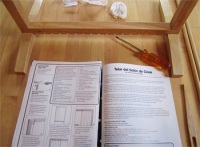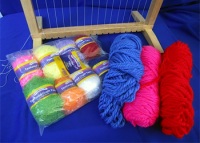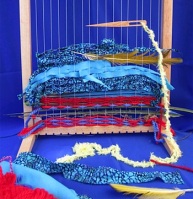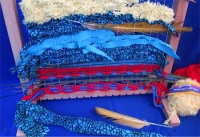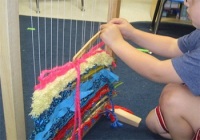Wait until you see this exciting display of children’s art from the College of the Canyons, and how open-ended preschool art looks when it’s beautifully displayed. This unique art exhibit was coordinated by CDC Director Monica Marshall and master teachers Kathy Walker and Faby Marton. You’ll see a wide range of creative paintings, weavings and collage, and some unique 3-D art applications. Get ready to feast your eyes!






I was particularly moved by the branch weavings that were inspired by reading Margaret Musgrove’s The Spider Weaver, a legend about Kente cloth weaving. The exhibit included children’s thoughts about the story itself. One of the branch weavings was done on burlap and a second version was created without burlap. Here Kathy Walker shows off the branch weaving without burlap, and comments that the burlap inset made it much easier for young children to weave. That’s something I wouldn’t have thought of, but it makes good sense as the burlap offers a large, loose fabric that big needles can carry yarn through. Nice to know!



These process paintings and 3-D constructions show that you can paint and collage onto practically anything. See if you can find the cardboard fruit inserts or paint stir sticks in these photos, they are the foundation for two of these wonderful creations.





Thanks to Monica Marshall, Director of the Child Development Center at College of the Canyons and to the Fine Art Department and Art Gallery Director that made this campus collaboration possible. The exhibit will was up for six weeks and included a beautiful color postcard called Budding Artists.
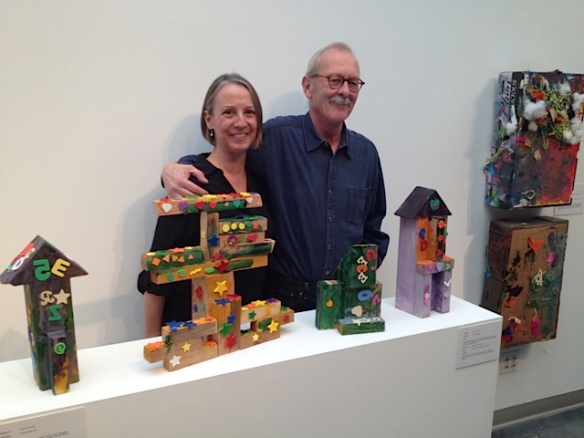

This awesome exhibit made me think of a story I recently heard from Anne Broussard, the delightful and highly experienced Child Care Coordinator at County of Orange. Knowing how much I love art, Anne told me this thought provoking story. As part of her job at the County, Anne was assigned to entertaining foreign diplomats and teaching them about early childhood education in the US. One afternoon she had guests from Iraq who were very interested in our preschool education system, so she was giving them a classroom tour. Her guests noticed some abstract art on the walls of a preschool classroom and asked her if a visiting artist had taught the children how to paint. They found it surprising to find so much art on the walls of the preschool, and were curious about it. She told them preschool teachers in America are taught to give children the opportunity to make art naturally, to follow their own instincts without imposing adult rules or values. The educators from Iraq were stunned, they really could barely believe that children would naturally create art that looked so “artistic”!
As this Budding Artist’s Exhibit illustrates, children’s natural creations are indeed very “artistic,” and it is precisely this open-ended discovery that gives art its true value. As children make their own choices with messy art, they discover the emotional pleasures of sensory and tactile play while developing important cognitive and social-emotional skills….skills that will help them in life.
As Abraham Maslov has said, “Art education is important not because it turns out artists or art products, but because it seems to turn out better people.”










